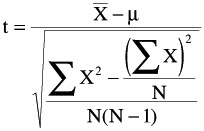TEST
TEST
The t test, often referred to as Student's t or the t ratio, was first described in 1908 in an article in Biometrika by William S. Gosset, who wrote under the pseudonym "Student." Gosset, a 32-year-old chemist, was a consultant for the Guinness Brewery in Ireland. (Here we have taken some liberties. The t ratio will be known as t [I], t [II], and t [III]. When the t is used with one group it is referred to as t [I]; with two independent groups, as t [II]; and with two related groups, as t [III].) In doing his research he discovered the t distribution, which permitted him to test hypotheses with small samples when the population had a normal distribution, the population mean was assumed, and the population standard deviation was unknown.
In the majority of small practical research problems, knowledge of the standard deviation is not available. If previous experience does not supply the standard deviation, one uses the t. In using the t to test a hypothesis, you calculate the t and then refer to a t table to determine the probability for this statistic.
t Test (I): The t test (I) is used with one-group samples where the population has a normal distribution. For example, suppose a population is assumed to have a mean of 1.85 meters and it has a normal distribution. We then reach into this population, pull out a sample, compute its mean, and compare its mean to the population mean of 1.85 meters by using the t test (I). If the difference between the sample mean and the assumed population mean is too large, then the assumption that the population mean is 1.85 meters is rejected. The requirements for the t test (I) are as follows :
-
At least the interval level of measurement
-
Random sample
-
Sample drawn from a population that has a normal distribution
The formula for the t test (I) is
that is, the sample means minus the population mean divided by the standard error of the mean. Using the formula for t does not require skills beyond what we already have learned. In effect, you are calculating a mean, a standard deviation, and a standard error of the mean. By using these three formulas, you can compute a t for any group of scores. To shorten this task, a formula that combines all the components is used:

The symbols you will encounter in learning about t (I) are ![]() = sample mean, ¼ = population mean, & pound ; X 2 = square each score, then find the sum of the squares, N = count the number of scores, ( X) 2 = square the sum of the scores, and df = N - I = degrees of freedom, number of scores minus one.
= sample mean, ¼ = population mean, & pound ; X 2 = square each score, then find the sum of the squares, N = count the number of scores, ( X) 2 = square the sum of the scores, and df = N - I = degrees of freedom, number of scores minus one.
EAN: 2147483647
Pages: 252